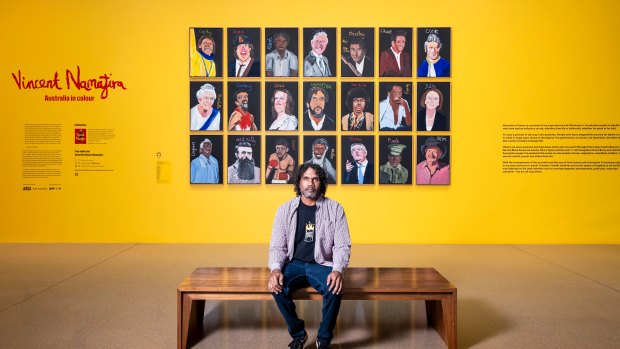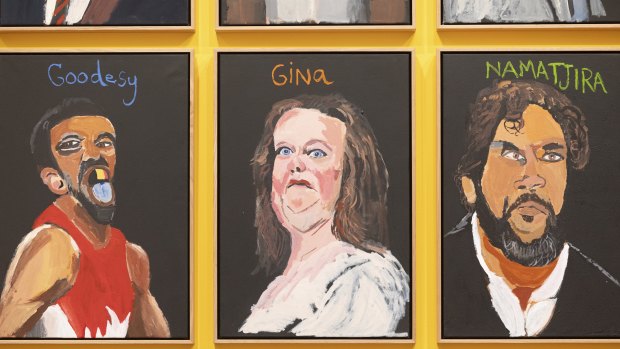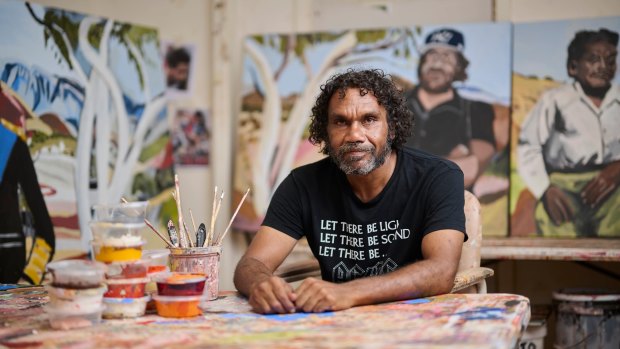This was published 1 year ago
The portrait Gina Rinehart doesn’t want you to see
By Linda Morris and Eryk Bagshaw
Australia’s richest person, Gina Rinehart, has demanded the National Gallery of Australia remove a portrait of her from an exhibition by Archibald Prize-winning Indigenous artist Vincent Namatjira.
The billionaire mining mogul directly approached NGA director Nick Mitzevich and NGA chair Ryan Stokes in April to press for the portrait’s removal.
There have since been more than a dozen complaints to the gallery from associates of her company, Hancock Prospecting, which have accused the NGA of “doing the bidding of the Chinese Communist Party” by displaying her image in an unflattering way.

Vincent Namatjira in front of his collection of portraits including Gina Rinehart.Credit: Rohan Thomson
Rinehart recently praised the Chinese government for “doing a better job than our government”, and it is unclear what the “bidding” referred to.
Complaints have also come from athletes she sponsors, according to sources who are familiar with the correspondence but who asked not to be identified due to the sensitive nature of the issue.
Ben Quilty, a friend of Namatjira who collaborated on an artwork for the show, said Namatjira was one of the most important artists of our times.
“If Olympic swimmers think they have so much say over the National Gallery, maybe Vincent and I should spend more time in the swimming pool,” Quilty said.
The portrait is one of 21 painted by the Western Aranda artist of notable Australian figures including Ned Kelly, Lionel Rose and his friend Adam Goodes.
It features in the first major survey at the NGA of Namatjira’s work, titled Vincent Namatjira: Australia in colour, which opened on March 2. Namatjira, a celebrated portraitist and a satirical chronicler of Australian identity, could not be reached for comment.
The gallery bills the show as one that takes a “wry look at the politics of history, power and leadership from a contemporary Aboriginal perspective”.

Vincent Namatjira’s portrait of Gina Rinehart at the National Gallery of Australia. Credit: Alex Ellinghausen
Rinehart’s request is understood to have been rejected by the gallery on the basis that the cultural institution’s artistic vision should not be swayed by individual public opinion. Rinehart is listed as a “friend” of the NGA on its supporters’ page after donating between $4999 and $9999 to the gallery.
In response to a series of questions about Rinehart’s complaint, Mitzevich issued a carefully worded statement from the gallery.
“The National Gallery welcomes the public having a dialogue on our collection and displays,” the gallery said.
“Since 1973, when the National Gallery acquired Jackson Pollock’s Blue Poles, there has been a dynamic discussion on the artistic merits of works in the national collection, and/or on display at the gallery. We present works of art to the Australian public to inspire people to explore, experience and learn about art.”
Rinehart was contacted for comment through Hancock Prospecting.
The dispute follows a series of controversies for the company’s executive chair. In March last year, Rinehart withdrew her $15 million sponsorship of Netball Australia after Indigenous player Donnell Wallam asked for her uniform not to include the Hancock Prospecting logo.
Wallam was protesting against comments made by Rinehart’s father and Hancock Prospecting founder, Lang Hancock, in 1984 that Indigenous Australians should be sterilised and “breed themselves out”.
Rinehart has refused to condemn her father’s comments and cancelled her funding for Netball Australia after players refused to wear her company’s logo.

Artist Vincent Namatjira.Credit: Rohan Thomson
In June, Rinehart claimed the West Australian government’s changes to Indigenous heritage laws, after Rio Tinto’s destruction of an ancient site at Juukan Gorge in 2020, would force home owners to get heritage approval to build granny flats in their backyards.
The 70-year-old has drawn praise from some Indigenous leaders for millions of dollars in funding given via the Roy Hill Community Foundation which provides scholarships, training, work experience and internships through the Madalah organisation.
Get alerts on significant breaking news as happens. Sign up for our Breaking News Alert.